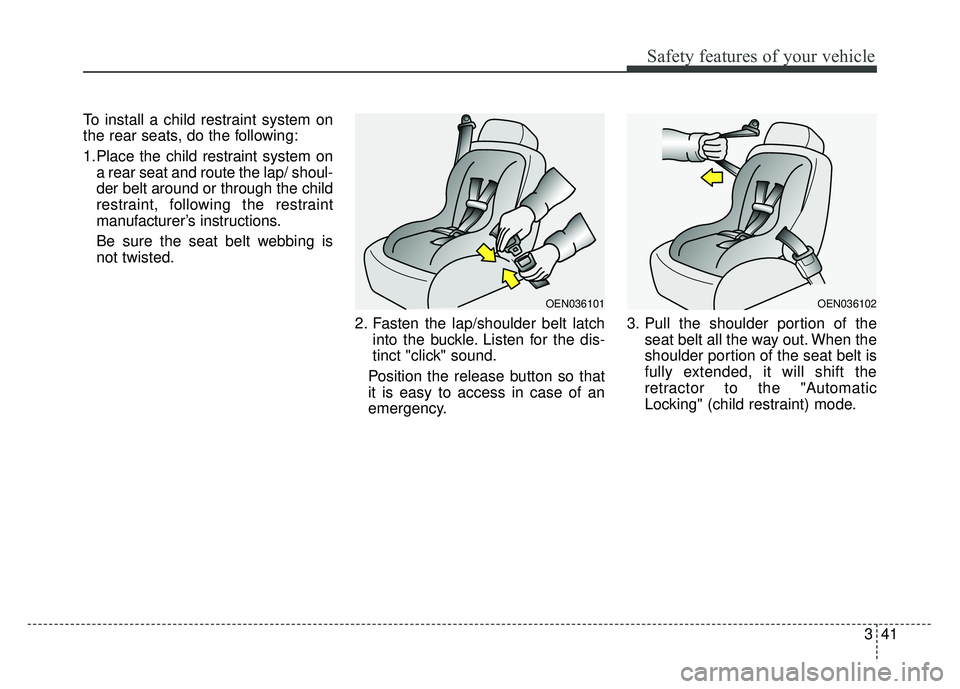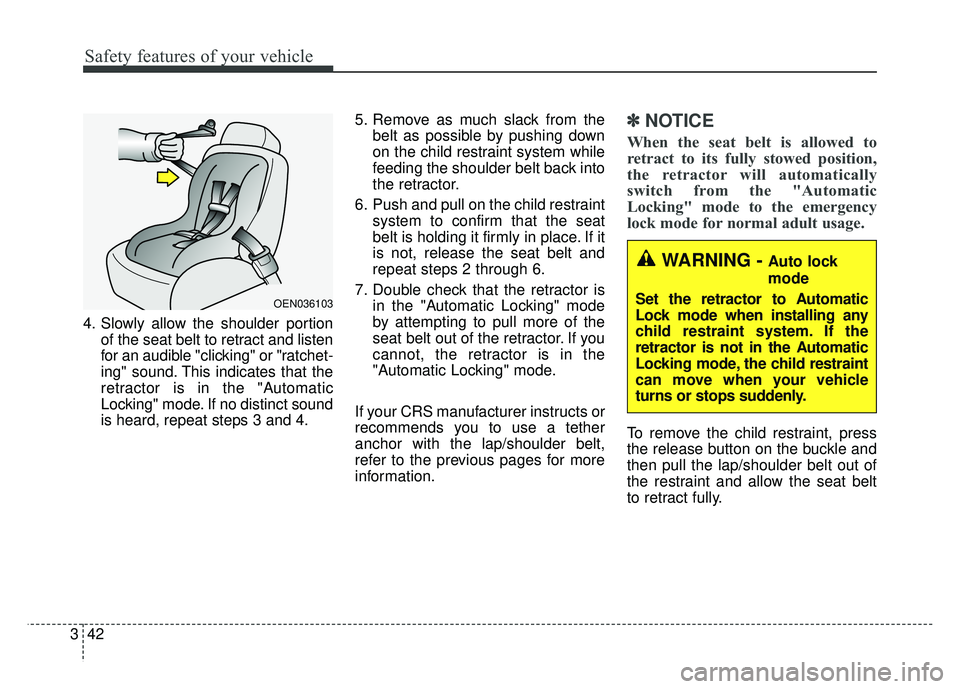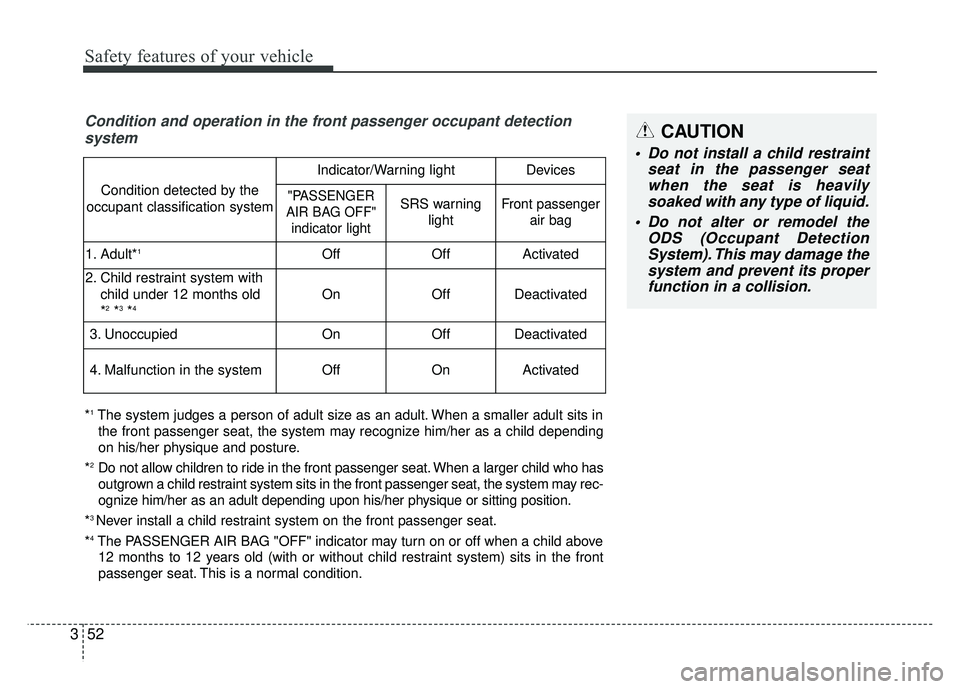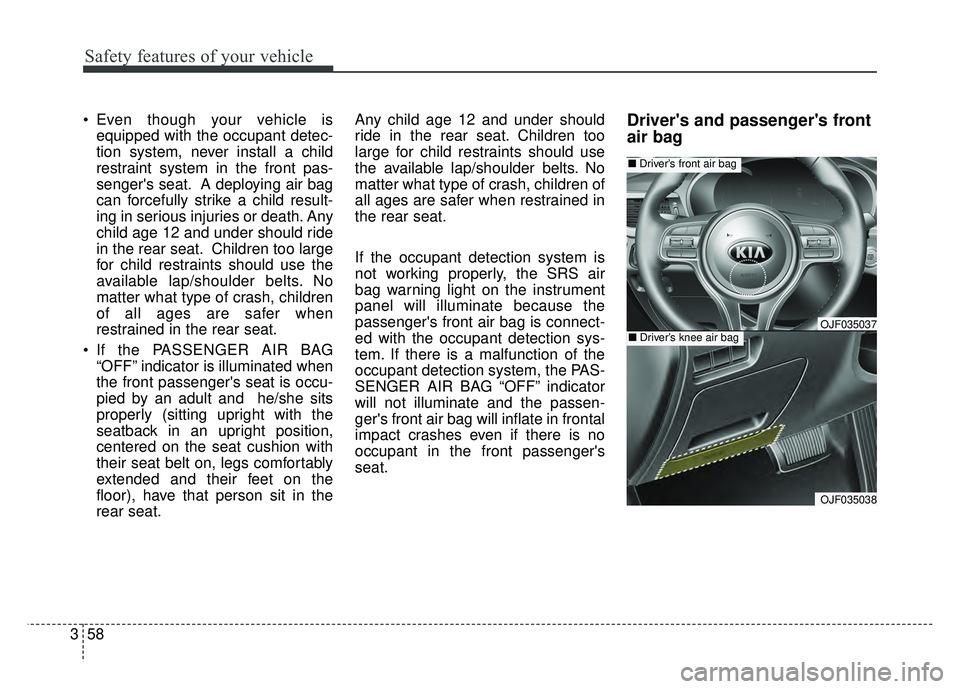2018 KIA OPTIMA PHEV child restraint
[x] Cancel search: child restraintPage 101 of 547

341
Safety features of your vehicle
To install a child restraint system on
the rear seats, do the following:
1.Place the child restraint system ona rear seat and route the lap/ shoul-
der belt around or through the child
restraint, following the restraint
manufacturer’s instructions.
Be sure the seat belt webbing is
not twisted.
2. Fasten the lap/shoulder belt latchinto the buckle. Listen for the dis-
tinct "click" sound.
Position the release button so that
it is easy to access in case of an
emergency. 3. Pull the shoulder portion of the
seat belt all the way out. When the
shoulder portion of the seat belt is
fully extended, it will shift the
retractor to the "Automatic
Locking" (child restraint) mode.
OEN036101OEN036102
Page 102 of 547

Safety features of your vehicle
42
3
4. Slowly allow the shoulder portion
of the seat belt to retract and listen
for an audible "clicking" or "ratchet-
ing" sound. This indicates that the
retractor is in the "Automatic
Locking" mode. If no distinct sound
is heard, repeat steps 3 and 4. 5. Remove as much slack from the
belt as possible by pushing down
on the child restraint system while
feeding the shoulder belt back into
the retractor.
6. Push and pull on the child restraint system to confirm that the seat
belt is holding it firmly in place. If it
is not, release the seat belt and
repeat steps 2 through 6.
7. Double check that the retractor is in the "Automatic Locking" mode
by attempting to pull more of the
seat belt out of the retractor. If you
cannot, the retractor is in the
"Automatic Locking" mode.
If your CRS manufacturer instructs or
recommends you to use a tether
anchor with the lap/shoulder belt,
refer to the previous pages for more
information.
✽ ✽ NOTICE
When the seat belt is allowed to
retract to its fully stowed position,
the retractor will automatically
switch from the "Automatic
Locking" mode to the emergency
lock mode for normal adult usage.
To remove the child restraint, press
the release button on the buckle and
then pull the lap/shoulder belt out of
the restraint and allow the seat belt
to retract fully.
OEN036103
WARNING - Auto lock
mode
Set the retractor to Automatic
Lock mode when installing any
child restraint system. If the
retractor is not in the Automatic
Locking mode, the child restraint
can move when your vehicle
turns or stops suddenly.
Page 106 of 547

Safety features of your vehicle
46
3
Do not install a child restraint on
the front passenger’s seat
Never place a rear-facing child
restraint in the front passenger’s
seat. If the air bag deploys, it would
impact the rear-facing child restraint,
causing serious or fatal injury.
In addition, do not place front-facing
child restraints in the front passen-
ger’s seat. If the front passenger air
bag inflates, it could cause serious or
fatal injuries to the child.
Air bag warning light
The purpose of air bag warning light
in your instrument panel is to alert
you of a potential problem with your
air bag system, which could include
your side and/or curtain air bags
used for rollover protection.1JBH3051
W7-147
WARNING- Air bag deployment
When children are seated in the
rear outboard seats of a vehicle
equipped with side and/or cur-
tain air bags, install the child
restraint system as far away
from the door side as possible.
Inflation of the side and/or cur-
tain air bags could impact the
child.
Page 112 of 547

Safety features of your vehicle
52
3
Condition and operation in the front passenger occupant detection
system
*1The system judges a person of adult size as an adult. When a smaller adult sits in
the front passenger seat, the system may recognize him/her as a child depending
on his/her physique and posture.
*
2Do not allow children to ride in the front passenger seat. When a larger child who has
outgrown a child restraint system sits in the front passenger seat, the system may rec-
ognize him/her as an adult depending upon his/her physique or sitting position.
*
3 Never install a child restraint system on the front passenger seat.
*
4The PASSENGER AIR BAG "OFF" indicator may turn on or off when a child above 12 months to 12 years old (with or without child restraint system) sits in the front
passenger seat. This is a normal condition.
Condition detected by the
occupant classification system
Indicator/Warning lightDevices
"PASSENGER
AIR BAG OFF" indicator lightSRS warning lightFront passenger air bag
1. Adult*1OffOffActivated
2. Child restraint system with
child under 12 months old
*
2*3*4OnOffDeactivated
3. Unoccupied OnOffDeactivated
4. Malfunction in the systemOffOnActivated
CAUTION
Do not install a child restraint seat in the passenger seatwhen the seat is heavilysoaked with any type of liquid.
Do not alter or remodel the ODS (Occupant DetectionSystem). This may damage thesystem and prevent its properfunction in a collision.
Page 118 of 547

Safety features of your vehicle
58
3
Even though your vehicle is
equipped with the occupant detec-
tion system, never install a child
restraint system in the front pas-
senger's seat. A deploying air bag
can forcefully strike a child result-
ing in serious injuries or death. Any
child age 12 and under should ride
in the rear seat. Children too large
for child restraints should use the
available lap/shoulder belts. No
matter what type of crash, children
of all ages are safer when
restrained in the rear seat.
If the PASSENGER AIR BAG “OFF” indicator is illuminated when
the front passenger's seat is occu-
pied by an adult and he/she sits
properly (sitting upright with the
seatback in an upright position,
centered on the seat cushion with
their seat belt on, legs comfortably
extended and their feet on the
floor), have that person sit in the
rear seat. Any child age 12 and under should
ride in the rear seat. Children too
large for child restraints should use
the available lap/shoulder belts. No
matter what type of crash, children of
all ages are safer when restrained in
the rear seat.
If the occupant detection system is
not working properly, the SRS air
bag warning light on the instrument
panel will illuminate because the
passenger's front air bag is connect-
ed with the occupant detection sys-
tem. If there is a malfunction of the
occupant detection system, the PAS-
SENGER AIR BAG “OFF” indicator
will not illuminate and the passen-
ger's front air bag will inflate in frontal
impact crashes even if there is no
occupant in the front passenger's
seat.Driver's and passenger's front
air bag
OJF035038
■
Driver’s front air bag
■Driver’s knee air bagOJF035037
Page 119 of 547

359
Safety features of your vehicle
Your vehicle is equipped with an
Advanced Supplemental Restraint
(Air Bag) System and lap/shoulder
belts at both the driver and passen-
ger seating position.
The indication of the system's pres-
ence are the letters "AIRBAG" locat-
ed on the air bag pad cover on the
steering wheel and the passenger's
side front panel pad above the glove
box.The SRS consists of air bags
installed under the pad covers in the
center of the steering wheel and the
passenger's side front panel above
the glove box.
The purpose of the SRS is to provide
the vehicle's driver and/or the front
passenger with additional protection
than that offered by the seat belt sys-
tem alone in case of a frontal impact
of sufficient severity. The SRS uses
sensors to gather information about
the driver's and front passenger's
seat belt usage and impact severity.
The seat belt buckle sensor deter-
mines if the front passenger's seat
belt is fastened.
These sensors provide the ability to
control the SRS deployment based on
whether or not the seat belts are fas-
tened, and how severe the impact is.
The advanced SRS offers the ability
to control the air bag inflation with
two levels. A first stage level is pro-
vided for moderate-severity impacts.
A second stage level is provided for
more severe impacts.
The passenger’s front air bag is
designed to help reduce the injury of
children sitting close to the instru-
ment panel in low speed collisions.
However, children are safer if they
are restrained in the rear seat.
According to the impact severity and
seat belt usage, the SRSCM (SRS
Control Module) controls the air bag
inflation. Failure to properly wear
seat belts can increase the risk or
severity of injury in an accident.
OJF035039
■
Passenger’s front air bag
Page 536 of 547

Index
4I
Center console storage . . . . . . . . . . . . . . . . . . . . . . . . 4-133
Central door lock switch. . . . . . . . . . . . . . . . . . . . . . . . 4-15
Chains - Tire . . . . . . . . . . . . . . . . . . . . . . . . . . . . . . . . . 6-96
Checking the amount of air conditionerrefrigerant and compressor lubricant . . . . . . . . . . . 4-127
Checking tire inflation pressure . . . . . . . . . . . . . . . . . . 8-46
Child restraint system . . . . . . . . . . . . . . . . . . . . . . . . . . 3-32 Selecting a Child Restraint System (CRS) . . . . . . . 3-33
Installing a Child Restraint System (CRS) . . . . . . . 3-36
Securing a child restraint with the LATCHanchors system . . . . . . . . . . . . . . . . . . . . . . . . . . . . 3-38
"Securing a child restraint seatwith" "Tether Anchor" "system" . . . . . . . . . . . . . . . . . . . 3-39
Child-protector rear door lock . . . . . . . . . . . . . . . . . . . 4-16
Clean air . . . . . . . . . . . . . . . . . . . . . . . . . . . . . . . . . . . 4-\
132
Climate control air filter . . . . . . . . . . . . . . . . . . . . . . . . 8-36 Filter inspection . . . . . . . . . . . . . . . . . . . . . . . . . . . . 8-36
Checking the amount of air conditioner refrigerant and compressor lubricant . . . . . . . . . . . . . . . . . . . . . . 4-127
Closing the sunroof. . . . . . . . . . . . . . . . . . . . . . . . . . . . 4-40
Clothes hanger . . . . . . . . . . . . . . . . . . . . . . . . . . . . . . 4-140
Combined instrument, see instrument cluster . . . . . . . 4-51
consumer assistance . . . . . . . . . . . . . . . . . . . . . . . . . . . 9-11
Coolant . . . . . . . . . . . . . . . . . . . . . . . . . . . . . . . . . . . . \
. 8-27
Coolant(Engine/Inverter) . . . . . . . . . . . . . . . . . . . . . . . 8-27 Checking the coolant level . . . . . . . . . . . . . . . . . . . . 8-27
Changing the coolant . . . . . . . . . . . . . . . . . . . . . . . . 8-30
Cooling fluid, see engine coolant . . . . . . . . . . . . . . . . . 8-27 Crankcase emission control system . . . . . . . . . . . . . . 8-102
Cruise control system . . . . . . . . . . . . . . . . . . . . . . . . . . 6-52
To set cruise control speed . . . . . . . . . . . . . . . . . . . . 6-53
To increase cruise control set speed . . . . . . . . . . . . . 6-53
To decrease the cruising speed . . . . . . . . . . . . . . . . . 6-54
To temporarily accelerate with the cruise control on . . 6-54
To cancel cruise control . . . . . . . . . . . . . . . . . . . . . . 6-54
To resume cruising speed at more than approximately 20mph (30 km/h) . . . . . . . . . . . . . . 6-55
To turn cruise control off . . . . . . . . . . . . . . . . . . . . . 6-55
Cup holder . . . . . . . . . . . . . . . . . . . . . . . . . . . . . . . . . 4-135
Curtain air bag . . . . . . . . . . . . . . . . . . . . . . . . . . . . . . . 3-63
Dashboard illumination, see instrument panel illumination . . . . . . . . . . . . . . . . . . . . . . . . . . . . . . . 4-52
Dashboard, see instrument cluster . . . . . . . . . . . . . . . . 4-51
Day/night rearview mirror . . . . . . . . . . . . . . . . . . . . . . 4-46
Daytime running light . . . . . . . . . . . . . . . . . . . . . . . . 4-100
Declaration of Conformity . . . . . . . . . . . . . . . . . . . . . . . 5-8 FCC . . . . . . . . . . . . . . . . . . . . . . . . . . . . . . . . . . . . \
. . 5-8
Defogging (Windshield) . . . . . . . . . . . . . . . . . . . . . . . 4-129
Defroster (Rear window) . . . . . . . . . . . . . . . . . . . . . . 4-114
Defrosting (Windshield) . . . . . . . . . . . . . . . . . . . . . . . 4-129
Dimensions . . . . . . . . . . . . . . . . . . . . . . . . . . . . . . . . . . . 9-\
2
Disarmed stage . . . . . . . . . . . . . . . . . . . . . . . . . . . . . . . 4-11
D